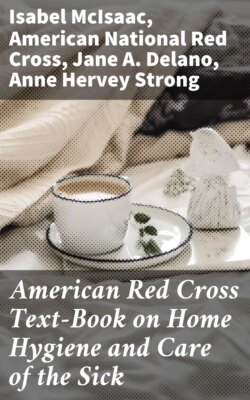Читать книгу American Red Cross Text-Book on Home Hygiene and Care of the Sick - American National Red Cross - Страница 19
На сайте Литреса книга снята с продажи.
TRANSMISSION OF PATHOGENIC ORGANISMS
ОглавлениеTable of Contents
Pathogenic or disease producing organisms need for their development food, moisture, darkness, and warmth, conditions that exist within the human body. When one or more of these factors is unfavorable, development of germs is checked; if unfavorable conditions are extreme or long continued, the organisms begin to die. It is difficult to say at exactly what moment they will die if deprived of moisture or exposed to extremes of temperature or other unfavorable conditions, just as it would be impossible to state at exactly what moment a collection of house plants would all be dead if water were withheld, or if the room temperature were greatly reduced.
Most pathogenic organisms, however, do not flourish long outside the body, and owe their continued existence to a fairly direct transfer from person to person. They gain access to the body through mucous surfaces such as the respiratory and digestive tracts, and through breaks in the skin, such as cuts, abrasions, and the bites of certain insects. They leave the body chiefly in the nasal and mouth discharges, as in coughing, sneezing, and spitting, in the urine and bowel discharges, and in pus or "matter."
Fig. 6. (L. H. Wilder.)
The problem of controlling communicable diseases, consequently, lies in preventing the bodily discharges of one person from travelling directly into the body of another. If a person is not expelling pathogenic germs, it is clear that he cannot pass diseases on to others. But both pathogenic and harmless germs follow the same routes from person to person, so that safety as well as decency lies in preventing so far as possible all exchanges of bodily discharges.
There are five routes by which the bodily discharges most frequently travel from one person to another. Four of these routes of infection are called public, because in most cases efforts of individuals alone are not sufficient to control them. The public routes are water, milk, food, and insects. The fifth, or private route, includes all means by which fresh discharges of one person are passed to another, as when nose and mouth discharges are carried in coughing, sneezing, and kissing, or when bowel and bladder discharges are carried by the hands. These five routes in a given case differ greatly in relative importance, but the fifth, or direct route plays an immense part, although its importance in causing sickness has only lately been recognized. It cannot be too strongly emphasized that the chief agent in the spread of human diseases is man himself, and the human hand is the great carrier of disease germs both to and from the body. If unclean hands could be kept away from the orifices of the body, particularly the mouth, many diseases would soon cease to exist.
